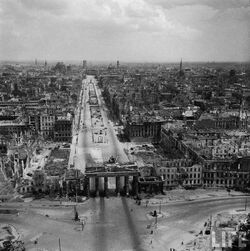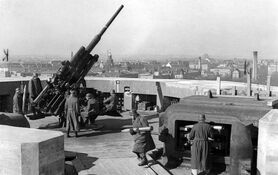
Berlin during 1945.
Berlin is the capital city of Germany. The last major conflict of the European Theatre took place in the capital and was known as the Battle of Berlin. Following the end of the war Germany as well as its capital were split into four between France, England, The United States, and the Soviet Union. The city of Berlin would later be split between the democratic allied side and the Soviet Union controlled side and split by the Berlin Wall which would become a staple of the Cold War.
During World War II[]
Air raids[]
The first air raid against Berlin was carried out by French bombers on June 7, 1940.[1]
The first RAF air raid against Berlin took place on the night of August 25th/26th, with eighty one Vickers Wellingtons, Armstrong Whitworth Whitleys and Handley Page Hampdens attacking industrial targets in the city. The RAF raid was launched in retaliation for a Luftwaffe bombing raid against London on August 23rd/24th, when ten aircraft dropped bombs on the heart of London due to a navigational error,[2] and was followed by raids carried out on August 28th and 29th.[3] To limit the effects of these attacks, the Germans adopted extensive camouflage to confuse enemy bomber crews. Lake Lietzen was covered in gauze, to prevent it's reflection of moonlight, as it was presumed to act as a navigational marker. An additional attempt to confuse the enemy resulted in the construction of at least five giant flimsy reproductions of Berlin. These were located at Nauen to the west, Pausin to the northwest and Schonlinde to the northeast, together with two others in the suburbs to the east and south.[4] Despite these precautions, the destructive effects of Allied air raids prompted a partial evacuation of Berlin on August 6th 1943.[5]

A FlaK 38 gun mounted on top of the Zoo Tower
Russia also launched air attacks against Berlin. The first such raid, carried out by five Estonia based Il-4s on August 8th 1941, ended in failure as two aircraft were shot down en route, two others failed to find Berlin, and the fifth dropped it's light load on railroad tracks outside the city.[6] Four more such raids are attempted, culminating in a futile attack on September 4th. Russian air bases in Estonia are evacuated, ahead of the complete German occupation of the country on September 5th.[7] This results in the suspension of Russian air raids against Berlin until August 30th 1942.[8]
The heaviest air raid against Berlin was launched on March 18th 1945, with the American Eighth Air Force dispatching a force of 1,250 bombers plus escorts, which were attacked for the first time by a force of German jet aircraft, in concert with other types. The German attack on the bomber force resulted in the loss of 24 bombers and 5 fighters, with another 600 bombers damaged.[9]
Land attacks[]
In addition to air attack, Berlin was also subjected to ground assault by Russian forces, especially during the last year of the war, with Russian troops reaching a point 70 miles from Berlin on January 30th,[10] before advancing another 20 miles by February 5th.[11]
Despite attempts by Winston Churchill to convince him otherwise, Eisenhower decided on March 28th, 1945 to leave Berlin to the Russians.[12] This led to a large Russian force beginning a drive for Berlin on April 15th, by attacking the German Ninth and Fourth Panzer armies along the Oder and Neisse rivers.[13] On 21st April 1945, The Russian 8th Guards Army, commanded by General Chuikov, penetrated the suburbs of Berlin.[14] The Russians completely encircled the city on April 25th,[15] but did not take complete control until May 2nd.[16]
References[]
- ↑ Goralski, Robert. World War II Almanac 1931-1945. Hamish Hamilton Ltd. 1981. ISBN 0 241 10573 0 Page 117
- ↑ Goralski, Robert. Page 129
- ↑ Roberts, Andrew. The Storm of War - A new history of the Second World War. Penguin Books. ISBN 978 0 141 02928 3. (2010). Page 100
- ↑ Goralski, Robert. Page 130
- ↑ Goralski, Robert. Page 276
- ↑ Goralski, Robert. Page 170
- ↑ Goralski, Robert. Page 173
- ↑ Goralski, Robert. Page 231
- ↑ Goralski, Robert. Page 387
- ↑ Goralski, Robert. Page 376
- ↑ Goralski, Robert. Page 377
- ↑ Goralski, Robert. Page 390
- ↑ Goralski, Robert. Page 397
- ↑ Goralski, Robert. Page 399
- ↑ Goralski, Robert. Page 400
- ↑ Goralski, Robert. Page 402
